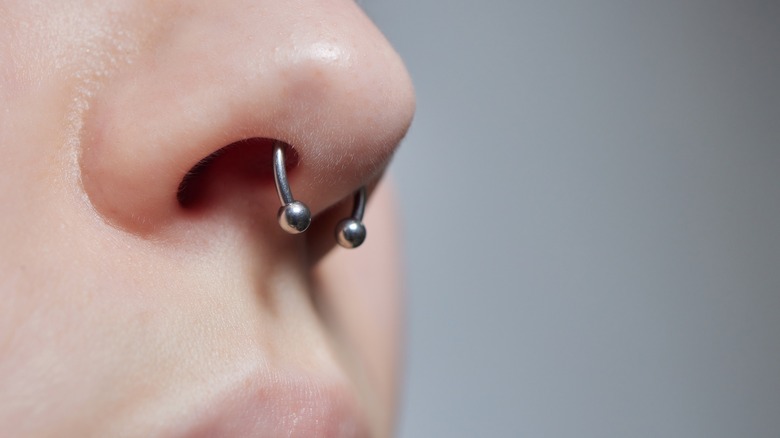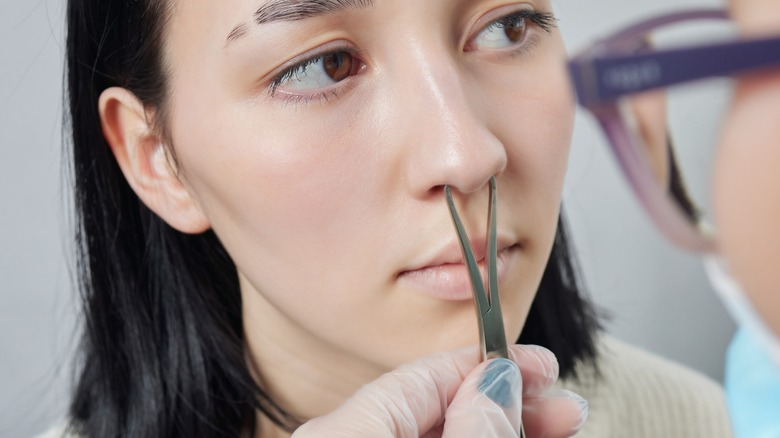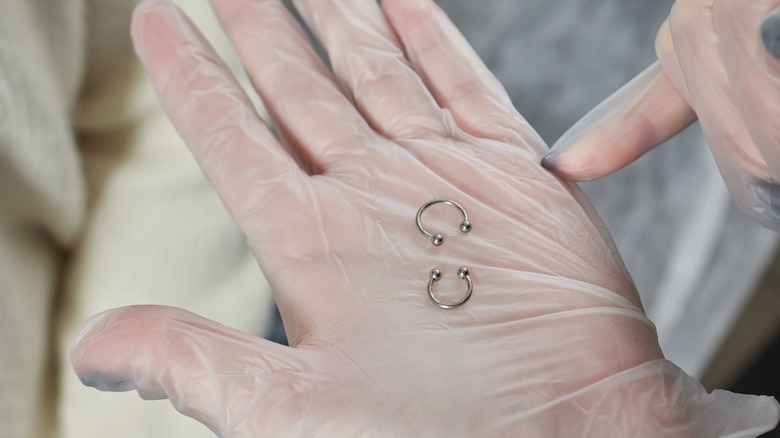Read This Before You Get A Septum Piercing
While celebrities like Willow Smith and Bella Thorne sport their minimalist septum hoops, Pinterest boards dedicated to body jewelry designs are gaining traction. Its clear nose piercings are one of the trendiest forms of body modification. Septum piercings are especially popular among students and workers as they are easy to flip up and hide within the nose (via Infinite Body). The septum of your nose is the thin strip of cartilage dividing your nostrils. Anyone with a cartilage piercing knows how difficult it can be during the healing process, which brings us to why septum piercings are so great. Septum piercings do not actually penetrate the cartilage dividing your nostrils, never mind that they are named after said cartilage. Instead, the little fleshy spot located right beneath the cartilage is pierced. This fleshy spot is the columella, or as piercers like to call it, the sweet spot. You can find it by holding your septum between your thumb and index fingers, of course, with clean hands.
Some people are born without a columella and so would have to get their cartilage pierced instead. But this is much more painful than a sweet spot septum would hurt and heals much slower, per TatRing. You now know the exact location of a septum piercing but there's still a lot to learn about the process. From cost to aftercare, here is your all-in-one guide on everything you need to know about getting a septum piercing.
How is a septum piercing done and how much does it hurt?
Piercings are a big deal and require a good amount of care and technique, so always go to an experienced and reputable piercer to get the job done. Different piercers have slightly different methods of piercing but it generally starts with you on the reclining table and your piercer disinfecting the sweet spot inside your nose. After holding the septum in place with forceps, your piercer will quickly insert the needle and pass a receiving tube into the recently created hole. Your jewelry, which you and your piercer would have discussed and chosen before the actual piercing process, will be fed through the tube and adjusted or closed (via Piercing Mania).
The process is pretty quick, taking only around two minutes, according to Healthline. But like all piercings, discomfort is unavoidable. The level of pain you'll experience depends on your pain tolerance and the technique or experience of the piercer. Some people describe the pain as a tight pinch that spreads into a dull throb, while others rate the pain pretty high. Either way, expect some pain while getting this piercing.
How about aftercare and how long does it take to heal?
The last thing you want after getting a new piercing is to lose it to a completely avoidable infection. Before and after the piercing, a good piercer should provide you with strict aftercare tips. But here are some general rules you need to follow to keep your piercing clean and healing fine. According to Platinum Tattoos, you'll need some saline solution, a sterile compress, or some non-woven gauze to dab around your septum piercing two to three times a day. It's crucial you don't rub or move the compress or jewelry around roughly while cleaning; only dab. Moving the jewelry around will only ruin recently formed scar tissue, cause discomfort, and deter the healing process. Also, avoid cleaning your piercing with disinfectants like iodine, alcohol, and hydrogen peroxide as they can irritate the area.
Septum piercings can take as long as six months to a full year to heal completely. We know that's a long time to wait for some variety, so Essential Beauty advises waiting at least three to four months before going back to your piercer for your first jewelry change.
What kind of jewelry do I use? And how much does a septum cost?
Piercings are invasive and stay in your skin and mucous membranes for months before you can change them out. This is why going for jewelry made from high-grade, hypoallergenic materials like titanium, niobium, fused quartz glass, or platinum is always a good choice. According to the Association of Professional Piercers (APP), titanium jewelry is great for people who are sensitive to nickel, while niobium is great for people who want a lot more color options with their jewelry. The APP also states that gold-plated or gold-filled jewelry is not the way to go with a fresh piercing as they can contain nickel. For the jewelry in your new piercing which will go through the receiving tube, your piercer will insert either a 14-, 16-, or 18-gauge circular horseshoe (via Urban Body Jewelry). Once the tissue of your septum is ready for a jewelry change, your jewelry options include barbells, septum clickers, retainers, closure rings, and horseshoes, per Body Candy.
Depending on the salon's location and your piercer's experience, the cost of a septum piercing may vary in different places. Nonetheless, Dr. Piercing states that the cost could be anywhere between $40 and $100. Keep in mind that this might not include the price of the jewelry used, so prepare to spend a little more money on higher-quality jewelry after discussing it with your piercer, per Piercee.
What are the risks with getting a septum piercing?
Sometimes, piercings can act up, including septum piercings. Even older piercings have the potential to get infected and cause problems again. This is why aftercare is essential (via Authority Tattoo). Problems that can affect your septum's healing process include infections due to poor aftercare and allergic reactions. People who are sensitive to metals like nickel may have adverse reactions to their piercing jewelry containing such metals, so it's vital to check and wear only hypoallergenic jewelry. Your piercing is most likely infected if the discharge from the area is colored, if there's redness or swelling which indicates inflammation, and/or if you have a fever, per Painful Pleasure).
For septum piercings, septal hematomas are another concern that can cause pain and swelling. According to Healthline, septal hematomas occur when the piercing damages blood vessels in the septum, causing blood to collect between the blood vessels and the tissue that makes up the septum. Ultimately, piercings are great because they can be lifelong decisions or short-lived ones. If you decide you do not want your piercing in anymore, gently take out the jewelry but still continue your aftercare while the hole closes. In either case, you still have the freedom to choose.




